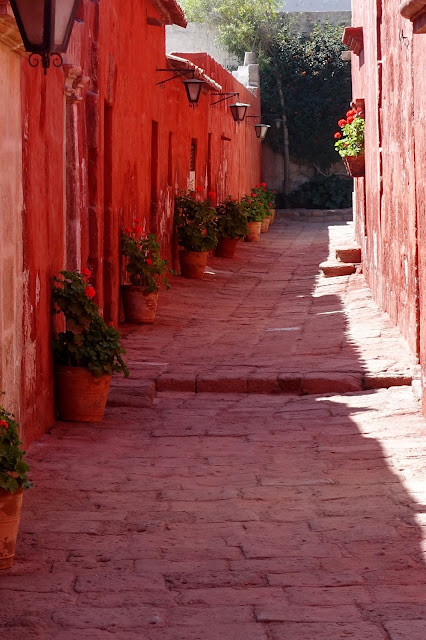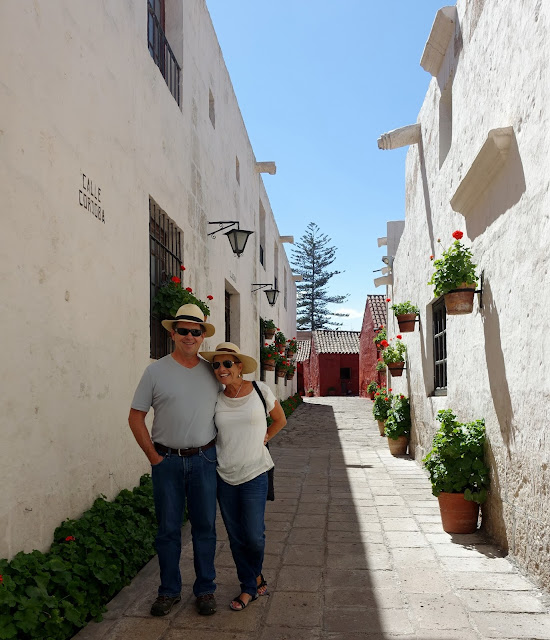Today we visit the Santa Catalina Monastery of Arequipa, the town's true landmark. I expect to see a beautiful old building, I expect to see humble living quarters; but what I learn about living here is completely unexpected.
First of all, this place is huge. It's over 215,000 sq feet, total, and it's been operated by nuns (continuously) for the last 4 centuries. So technically, it should be referred to as a convent, but. The monastery name has just stuck.
I'm immediately engaged.
This large, beautiful, colorful monastery was originally built in 1579, and housed about 124 nuns. We are told by our guide that there is a small group of about 20 nuns still living in the northern corner of the complex, while the rest of the monastery is open to the public.
Walls were all hand-painted with natural pigments back in the day; we are told this tradition is still followed, and that they must be repainted every year after the rainy season.
The colors are bold, beautiful, and distinctive.
The nuns here at Santa Catalina are "cloistered" nuns ~ which simply means, that once they enter the convent, they do not ever go back outside it's walls. This is how they will visit relatives and loved ones, parents, even, for the rest of their lives ~ through a grate like this in the "visitation quarters".
And they are sent to live at the monastery -- get this -- at the age of 12.
Wow, I have to say that seems so harsh to me!
It was the custom of the time that the 1st born child was to be married (to carry on the family name, of course);
The second born was destined to be a nun or a priest (to pray for the family and elicit blessings for their family's sacrifice)
and the 3rd-born was destined for the military, assuming it was a male child; or to raise a family if it was a female.
I have to say, I was shocked to hear this. What if I'm the second born and I don't WANT to live in silence?? What if I WANT to be married and have babies? What if, heaven forbid, I actually have some talents that I want to use in other arenas? A destiny chosen for me strictly by birth order is not something I think could easily accept.
The other interesting point that our guide told us, was that they enter at age 12, but they don't really decide or "choose" if they want to stay until age 16. When we pressed her on this, she admitted that they really couldn't say no, they must always say yes. Wow. Some choice.
Now I'm looking at the rest of the convent in a different light. Thinking back to when I was 12 years old, I've now been separated from my parents and siblings, and I am facing a world that will never be any bigger than this. For my entire life.
Sobering thoughts followed my footsteps through the rest of the convent.
The buildings are separated by streets named after Spanish cities. There are channels running down the sides to accommodate the rainy season.
There are 84 houses here; at it's height the monastery housed about 450 people ~ a third of them nuns, and the rest servants.
There are 84 houses here; at it's height the monastery housed about 450 people ~ a third of them nuns, and the rest servants.
The custom of the time, as I stated previously, was for the second son or daughter to enter a life of service to the church.
Here's the kicker, though ~ the monastery only accepted women from upper class Spanish families. And each family had to pay a huge dowry of 2,400 silver coins ~ equivalent to $150,000 US today. That's astounding to me! And I have to wonder ~ how do these things become "the custom of the time"?
In addition the nuns (remember these are 12-year-old girls we're talkin' about) were required to bring a list of 25 items, including such things as a statue, a painting, a lamp, and clothing. Which makes no sense to me when you see how sparsely they lived; and when you know that they are wearing the robes of the nuns; So did the church sell off these extra items? I don't really know.
Most of the walls, furniture and such are original here, so......it looks to me as though they lived pretty sparsely. The beds, we are told, are always placed under an arch, which is the safest place to be during one of the earthquakes that are so frequent in this area.
Peaceful alcoves and courtyards are abundant.
The nuns were well-educated from within these walls, including lessons in music and the arts. This small schoolroom is where they would have spent many hours a week. Sometimes the monastery would accept a nun without a dowry, if they had a particular expertise in a musical instrument, for example, and could be useful as teachers.
Again, I sort of get it, but I sort of don't get it. If I'm an aristocratic affluent Spanish family, I would not want my children to be uneducated, even those that I sacrifice to the church. However, to what purpose are they literate in Latin, to whom do they play the violin for, and what use is their knowledge of world geography when they will never step outside the convent walls? I'm stumped.
You can tell that this concept of never leaving these walls once you enter is unsettling to me........it brings words like "trapped" and "imprisoned" and "confined" and "suffocating" to mind.......
In the beginning, we are told, many of the wealthy families sent servants along ~ to do the cooking and laundry, I'm assuming, as there was very little other that these young children might need done for them here. Many sent rich furnishings, rugs, and such; the wealthiest nuns brought things like fine English china and silk curtains.
Eventually, though, someone decided this was not in line with the concept of sacrificing everything for the church, and put a stop to it. Sister Josepha Cadina was sent by the Pope to straighten things out back in 1871. She sent all the riches back home to Europe, and freed all the servants and slaves, giving them the option to become nuns themselves or leave the convent.
There were individual kitchens in some of the houses;
The kitchen and it's utensils are remarkably untouched by time. I like the potato grater on the bottom left.
Handy to have the well right in the kitchen, yes?
Also adjacent to the kitchen is your official Guinea Pig pen. Oh my!
Yes, they're real.
Yes, they're alive (for the moment).
Yes they're adorable.
And yes, they really do eat guinea pig here in Peru.
This is an interesting water filtration system. The rock here is volcanic, thus porous; as the water drips through, impurities are filtered out. Still working today as well as it did back then.
I'm glad to be a firstborn, that's all I can tell 'ya.
There is a small chapel for daily worship.
And a big laundry room. Another of the more interesting aspects of this monastery, this innovative laundry system was added in 1770. There are 20 huge earthen jars, broken in half, all connected to the main aqueduct of Arequipa. To fill the jars, you simply remove a cork which plugs the "faucet" when not in use (which you can see our guide is demonstrating for us); let the water drain in, and you're in business. Or maybe your servant is in business.
We appreciated having a guide, who we hired right on site; this is one of those spots that what we learned was even more interesting than what we saw.
We wandered about a bit on our own once our tour finished.
But here's what I'm really looking for.
The Door. The Salida. The Exit.
I'm happy to leave. Just because I can.
























No comments:
Post a Comment
Join the conversation ... comment now!